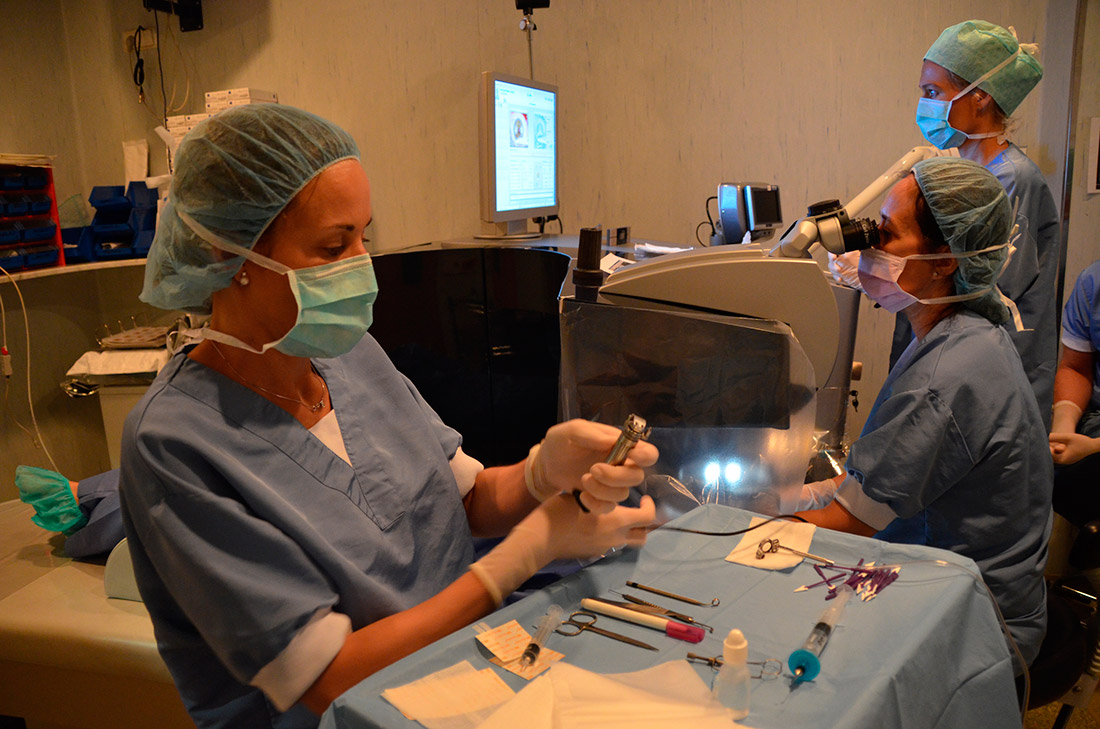Refractive Surgery
What is refractive surgery?
Refractive surgery cover a series of ocular techniques, the objective of which is to eliminate the eye’s refractive error, removing the need for glasses.
The type of operation advised will depend on a patient’s age, refractive errors and eye characteristics. It is sometimes not possible to carry out a specific surgery type, so as not to endanger ocular health
Refractive surgery with a femtosecond laser.
Types of refractive surgery
LASIK
The laser acts by shaping the cornea to correct dioptres, applying heat to the cornea tissue. A superficial cornea strip similar to a sheet of paper called a flap is created in advance. This is 100-120 microns thick. Once created, it is lifted up, the excimer laser is applied and it is placed again. The recovery with this procedure is very fast.
The flap can be created:
- Through a mechanical microkeratome (blade). This is the traditional method, although it is now used less frequently in comparison with the femtosecond laser.
- Using a femtosecond laser. With the femtosecond laser, the surgeon ensures that they can accurately cut the flap to the desired thickness.
PRK
This laser acts directly on the cornea, i.e. without the flap. Recovery is slower because a more extensive area of the cornea needs to be scarred, but it is the preferred option in certain cases (thin cornea, a higher possibility of ocular trauma).
Phakic lenses
The lens is placed between the iris and the crystalline lens. It is used when a laser operation is not advised, for example when the patient has a high level of myopia.
Extraction of the transparent crystalline lens
This is a similar surgery to cataract extraction. Normally the multifocal intraocular lens is implanted, so the patient is able to see at any distance. It is usually recommended for high refractive error, or when phakic lens surgery cannot be carried out, among other reasons.
OTHER SPECIALITIES
Frequently Asked Questions
In order to be able to treat eye refraction errors (myopia, hypermetropia and astigmatism), there must be a stable prescription, which usually occurs between adolescence and the age of twenty.
Refractive surgery is carried out under local topical anaesthetic (drops) and therefore, there will be no pain during the operation. After a few days, there may be some irritation (more so with PRK) but pain is rare.
A safety device known as an eye-tracker compensates for involuntary eye movements, monitoring the position at millisecond intervals and adjusting the direction of the laser at each moment. If the eye moves too much, the safety system stops the laser completely.
Although the percentage is low, some complications may arise. The most common is a dry eye sensation (which can be treated with artificial tears) and seeing halos around light (which will disappear after a few days in the majority of cases). A much less frequent but more serious complication is developing an infection. This can normally be treated and will not leave any permanent effects. Maximum care is always taken to avoid infections.
- You no longer need glasses or contact lenses.
- You will have more convenience and freedom in your daily life and when doing sports.
- It is a fast, safe, minimally invasive surgery.
- Hospitalisation is not required, results are immediate.
- Comfortable and convenient.
- Improved quality of life.
- Avoiding conditions caused by the prolonged use of contact lenses.
- Aesthetic benefits.
Related entries
Refractive surgery with intraocular lenses
Refractive surgery is used to eliminate or reduce the need to use glasses or contact lenses in the cases of…


